Citrus - winter's golden glow
As small compact trees, citrus fit into most gardens and grow well in pots.
Cultivating citrus goes way back in garden history. The ancestors of today ’s trees have been cross-breeding for centuries, their natural origins spread over an expansive area from the north of China, through India and southern Asia to Queensland, Australia. Generally, citrus prefer warmer climates, but the hardiest among them are surprisingly cold tolerant.
When choosing a citrus tree for your garden there are a few things to consider:
Winter hardiness
Cold tolerance varies among different types of citrus. In general, lemons and limes are the most cold sensitive, followed by grapefruit, then oranges, mandarins and kumquat (the most cold tolerant). The Japanese Satsumas tend to be the most cold tolerant of the mandarins. The Meyer, which has cold hardy citrus in its parentage, is the most cold hardy lemon to grow in southern regions.
Tree size
Most citrus varieties can be grown in a small garden. Grapefruit trees need the most space. Oranges and some lemon trees can also grow quite large, but most are easily kept in bounds with pruning, especially if grown on a dwarfing rootstock. Lemon trees can be trained as wall plants for those keen to try the art of espaliering against a sunny wall or fence line. Pruning to control size and shape is best done in spring before the lemon tree borer insect gets busy and to avoid frost-sensitive new growth in autumn.
TIP: Thin out the tree when pruning to let the sunlight in. The sunniest branches are the best fruiters.
Harvest time
Check for ripening time when planting a new variety. It’s possible, if you have space, to have citrus to pick most of the year. The season extends from early winter right into spring and summer too. In warmer regions the Meyer lemon may fruit any time of year. An early variety, such as Mandarin Miyagawa, will fill the fruit bowl over April and May. Silverhill is a great mid-winter mandarin. Clementine mandarins and Navel oranges ripen in spring. Late varieties, like Mandarin Encore and Orange Harwood Late, provide plentiful picking from November and well into the new year.
Fruit without seeds
Eating a mandarin is much more fun when there are no seeds to spit out. While many varieties are seedless, this depends on the fruit not having been pollinated by a bee that visited a different citrus variety growing nearby.
Seedless citrus varieties are not self-fertile, so they don ’t set seed when grown in orchards of identical plants. This is coupled with a genetic trait known as ‘parthenocarpy ’ , where a tree can produce fruit without its flowers being fertilised.
Skins
Thick skins or thin? Meyer lemon, with its thin smooth skin and bright yellow colour, is very attractive as a slice in a drink. Cooks might choose a traditional thicker skinned Eureka or Lisbon style lemon for its intensely flavourful zest. If you have children, easy peel mandarins that divide perfectly into segments are the way to go.
Flavour
Tartness and sweetness vary too. Lemons in particular range from mild Meyer to strongly acidic varieties favoured by chefs. The New Zealand bred Lemonade is a sweet, low acid variety. Some say Clementines have the best mandarin flavour of all, enough to compensate for any seeds and tight skins.
Aesthetics
While all citrus trees make an attractive addition to the garden, there is distinct variation in the shapes of trees, the colours, size and shape of fruit and subtle foliage differences.
Feeding citrus trees
Citrus trees need regular feeding. They need plenty of nitrogen for growth, potassium for flowering, fruiting and root growth plus trace elements like iron, zinc, magnesium and manganese.
Compost, blood and bone and animal manures supply useful nitrogen and phosphorus. Potassium can be added in the form of sulphate of potash, while regular foliar spraying with seaweed is a good source of trace elements. However, a good citrus fertiliser applied as directed, is the easiest way to provide a reliable balanced diet.
The amount to apply depends on the type of fertiliser and the age of the tree. Spread evenly at the recommended rate around the drip-line of the tree, not too close to the trunk.
Healthy, well-fed citrus trees are better looking, more productive and the most resistant to pests and diseases. Yellow or mottled leaves are a sign that your tree needs a feed, but this may also be due to poor drainage or cold temperatures.
The big chill
Following a frosty winter morning the youngest growing tips of a citrus tree may turn an insipid shade of pale green, or worse, burn to black. The longer the freeze, the greater the carnage. Both fruit and foliage are vulnerable when freezing temperatures extend over a few hours and a big freeze can kill a young tree. The colder your winter, the more you will need to pamper your citrus trees.
- Choose the warmest, sunniest, most sheltered spot. The sunny side of a heat absorbing concrete block wall may offer an ideal microclimate, even though you may need to water more when planting close to walls. Trees that were water stressed over summer are more susceptible to winter damage.
- Feed them generously in spring and summer. Healthy, well-nourished trees are the best equipped to cope with the cold. Avoid feeding in autumn, as this promotes soft growth susceptible to frost damage.
- Prune in spring. This way, the resulting new growth has time to mature and ‘harden off’ before winter. Resist the temptation to cut off frost damage until after the risk of frost. As the tree grows in spring, frost damaged branches will be easy to distinguish from healthy ones.
- A good, cold hardy vigorous rootstock gives another layer of protection. In New Zealand, most citrus (except lemons) are grown on a hardy rootstock of Poncirus trifoliata, which is also semi-dwarfing, protects against virus, while supporting high yields of quality fruit.
- Young trees are the most vulnerable. It’s heartening to know that trees become more cold tolerant with age, but it’s well worth protecting young trees with frost cloth. Laying gravel or stones under citrus trees can also help to trap the heat.
- Plant in pots. For centuries, in coldest climates, as in the famous ‘orangeries’ of Europe, citrus have been grown in pots brought into shelter over winter. Exceptional plants were considered worth going to exceptional lengths for.
Growing citrus trees in pots
Citrus trees make very appealing container subjects and have been grown this way for centuries, providing the ideal solution in the coldest climates, where they are moved indoors for winter. Container culture is also a good option if your soil is poorly drained.
The most successful citrus for pots include: Meyer lemon; Tahitian lime, Kaffir lime, mandarins, or trees grafted on dwarfing rootstocks. Orange trees make beautiful container specimens for large pots.
For best results choose a large well-drained container, a sunny, sheltered location and top quality planting mix. Use pot feet or bricks to raise the pot off the ground for best drainage. If a large pot is to be moved in the winter, consider sitting it on a platform with wheels. Or look for a pot with inbuilt wheels.
Water regularly to keep the potting mix moist at all times. During hot, dry weather, citrus in pots need a thorough soaking every 2 to 3 days. Citrus need ample feeding. Feed with controlled release fertiliser in spring and supplement with regular liquid feeding. Do not use powdered citrus fertilisers in pots as they may burn the roots.
Covering the top of the potting mix with bark or pebble mulch helps to retain moisture and protect surface roots. Once they reach the desired size, trees can stay in the same pot for several seasons provided they are regularly fed.
Planting citrus trees
Choose a location with as much sun as possible. Dig a hole slightly deeper than the nursery pot and twice as wide. Back fill to the correct level so that the tree will sit in the soil at the same soil level as it was in the pot. It is important to plant at the right depth with the graft union above the soil line. Gently remove the nursery bag or pot, check the hole depth is right and fill with soil so that the roots are snuggly anchored. Water thoroughly. The roots should not be visible, but take care not to pile soil or mulch around the stem.
Troubleshooting
Yellow leaves: Cold weather or needs feeding. Feed in spring.
Mottled leaves: A sign of nutrient deficiency.
Sticky or puckered leaves: Sucking insects such as aphids and whitefly secrete honey dew and cause leaves to curl and crinkle. Spraying with household detergent mixed with oil is a home remedy for the control of these insects.
Black mould on leaves: Sooty moulds are fungi, which feed on honeydew secreted by sucking insect pests. Spray to control the insects and the mould will dry up and wash off in the rain.
Tree is shedding leaves: This may be caused by cold weather, wet feet or dryness.
Tree is shedding fruit: Lack of water or nutrients. Blossom end rot (a cause of fruit drop) is due to impaired calcium uptake, often due to dry weather. Thin out heavy crops in early summer to help tree health.
Pruning citrus trees
Pruning, though not essential, helps to shape the tree, control its size and remove any dead or damaged wood. Remove any shoots emerging from the rootstock below the graft union, as these will rob the tree of its vigour.
The best time to prune citrus is in spring, before October when destructive borer beetles start laying their eggs. In frost prone areas later pruning may be necessary to avoid stimulating new growth that is sensitive to frost. Seal cuts with pruning paste a a barrier to pest entry.
How you prune can depend on what you want from your tree. Trimming back new growth in spring can maintain an attractive bushy shape without affecting fruit yield (flowers and fruit grow on the subsequent new growth). Pruning to allow more sun into the tree improves fruit yield and quality.

15-Jun-2022
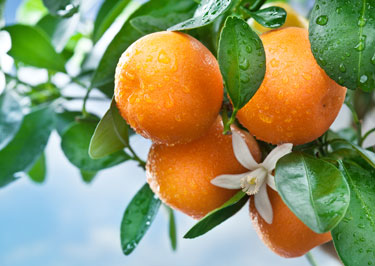
Tangelos
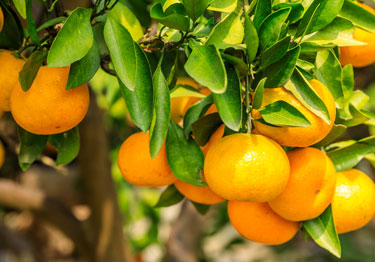
Mandarins

Limes - the yellow fruit are riper and sweeter than green limes.
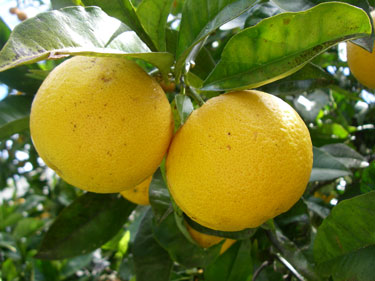
Grapefruit
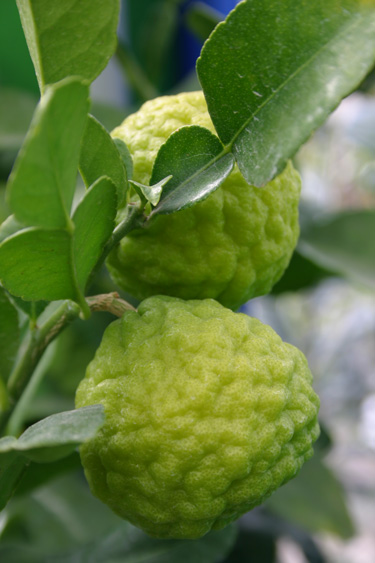
Kaffir lime - the leaves are used in Asian cuisine.
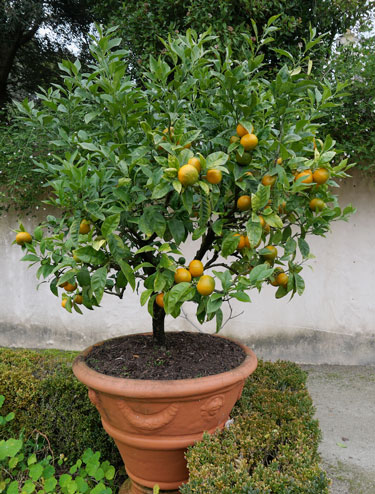
Orange growing in a terracotta pot in the Italian section of Hamilton Gardens.
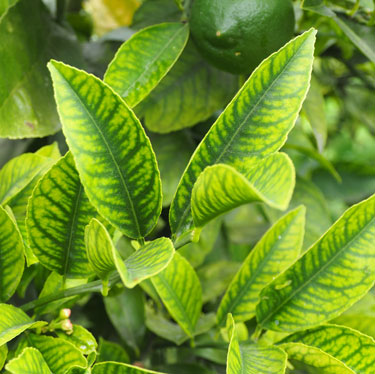
Iron deficiency in citrus. Feed with Yates Iron Chelate solution.
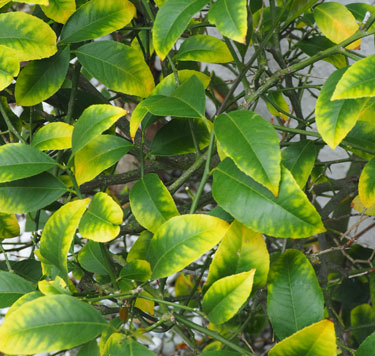
Magnesium deficiency in citrus. Feed with Yates Magnesium Chelate solution.
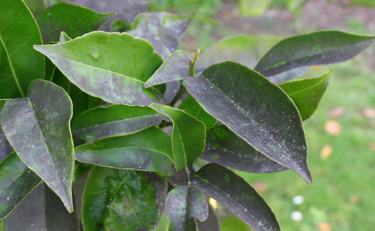
Sooty mould, a fungus that grows on the sweet excretion from scale insects.
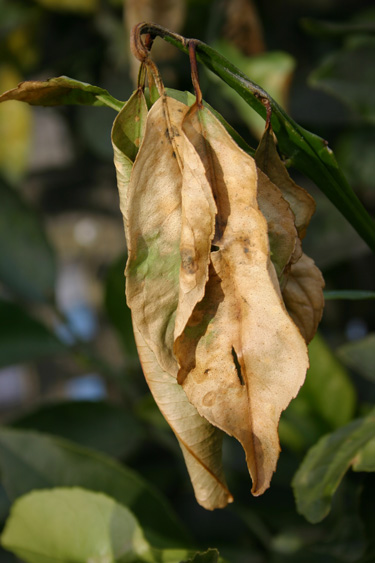
Frost damage

